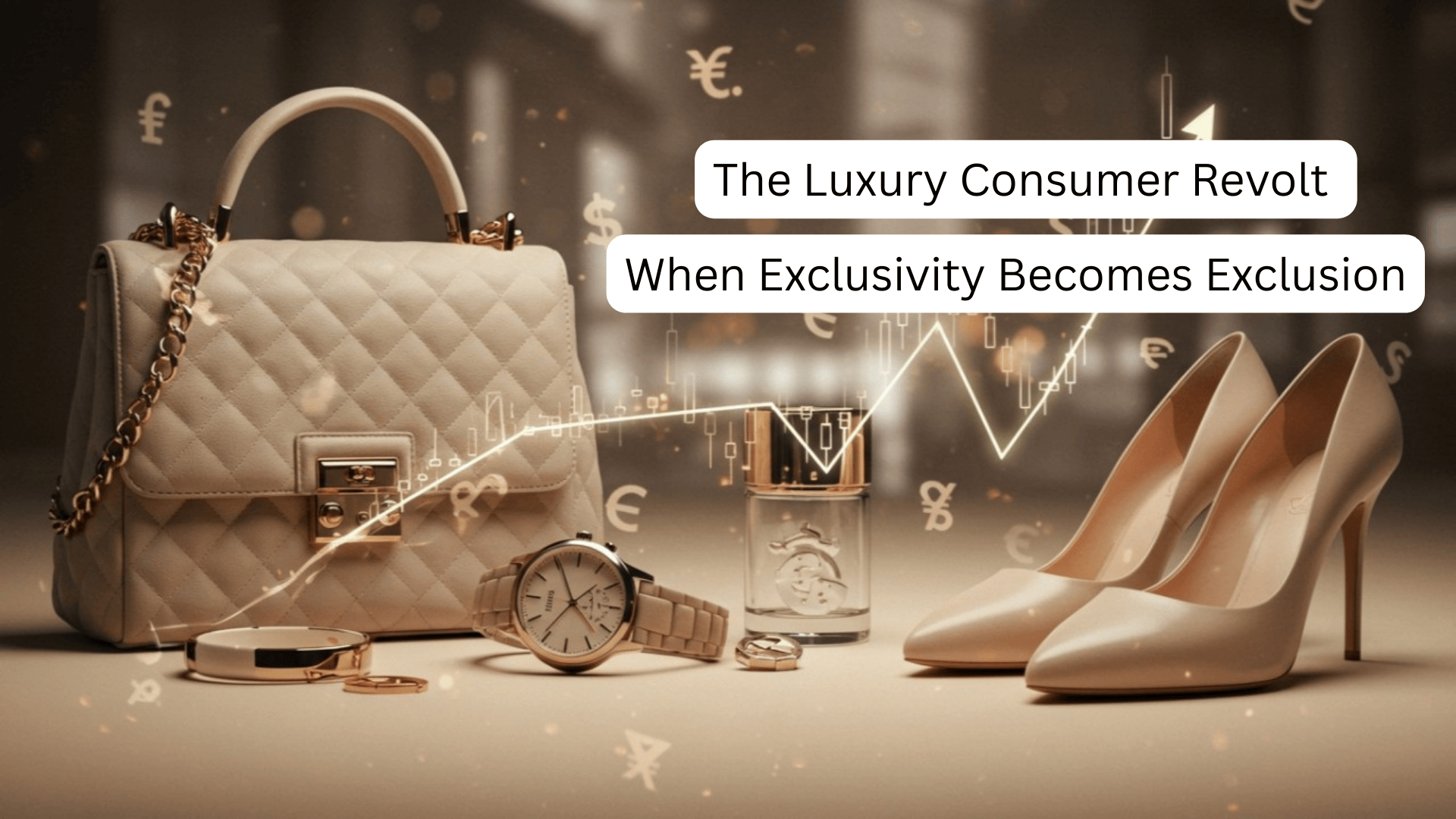
The Luxury Consumer Revolt | When Exclusivity Becomes Exclusion
Fifty million luxury consumers abandoned the market as prices rose 52% since 2019, validating our strategic analysis. Shopping became bureaucratic rather than enjoyable, creating "greedflation" backlash. This explains why focused authentic luxury and accessible premium succeed while confused positioning fails. Digital disruption made scarcity meaningless, consumers shifted to experiential wealth, and alternatives emerged from vintage to "dupes." Consumer choice now determines luxury strategy success.
#LuxuryConsumers, #ConsumerRevolt, #Greedflation, #LuxuryPricing, #AuthenticLuxury, #LuxuryStrategy, #ConsumerBehavior, #ExperientialWealth, #LuxuryBacklash, #DigitalDisruption, #StatusSymbols, #DupeCulture, #VintageLuxury, #ConsumerChoice, #LuxuryRecovery, #BrandAuthenticity, #LuxuryFuture, #ConsumerEmpowerment

Preview | Lululemon Lesson | How Athleisure King's Stumble Reveals the Fragile Nature of Fashion Dominance
Lululemon's 2025 struggles illustrate how quickly premium fashion brands can fall from grace when multiple challenges converge. The athleisure giant faces declining sales as fashion trends shift toward baggy styles, core customers reject new product lines, and economic pressures make luxury athletic wear less appealing. Combined with supply chain vulnerabilities, increased competition, and the commoditization of technical athletic wear, Lululemon's premium positioning is under serious threat. The company's experience offers critical lessons about maintaining cultural relevance, authentic growth strategies, and the fragility of fashion dominance in an increasingly volatile retail landscape.
#Lululemon, #Athleisure, #PremiumBrands, #FashionTrends, #RetailStrategy, #BrandStrategy, #AthleticWear, #Activewear, #FashionBusiness, #RetailAnalysis, #BrandManagement, #ConsumerTrends, #LuxuryRetail, #Sportswear, #BusinessStrategy, #MarketingStrategy, #FashionIndustry, #RetailTrends, #BrandPositioning, #ConsumerBehavior

The Lululemon Lesson | How Athleisure King's Stumble Reveals the Fragile Nature of Fashion Dominance
Lululemon's 2025 struggles illustrate how quickly premium fashion brands can fall from grace when multiple challenges converge. The athleisure giant faces declining sales as fashion trends shift toward baggy styles, core customers reject new product lines, and economic pressures make luxury athletic wear less appealing. Combined with supply chain vulnerabilities, increased competition, and the commoditization of technical athletic wear, Lululemon's premium positioning is under serious threat. The company's experience offers critical lessons about maintaining cultural relevance, authentic growth strategies, and the fragility of fashion dominance in an increasingly volatile retail landscape.
#Lululemon, #Athleisure, #PremiumBrands, #FashionTrends, #RetailStrategy, #BrandStrategy, #AthleticWear, #Activewear, #FashionBusiness, #RetailAnalysis, #BrandManagement, #ConsumerTrends, #LuxuryRetail, #Sportswear, #BusinessStrategy, #MarketingStrategy, #FashionIndustry, #RetailTrends, #BrandPositioning, #ConsumerBehavior

The Impact of a Weakening Dollar and Rising Gold Prices on Luxury Brands
The luxury market faces new challenges with the weakening of the dollar and surging gold prices. As the dollar declines against the euro and gold prices exceed $3,500 an ounce, European luxury brands may need to adjust their pricing strategies due to increased costs and changing consumer purchasing power. This economic scenario forces brands to manage their profit margins carefully, potentially leading to price hikes, especially in markets such as the U.S. and China. The situation is compounded for luxury watch and jewelry makers by the rising costs of gold. Additionally, a weaker dollar could diminish overseas shopping appeal for American consumers, affecting sales in traditional luxury shopping destinations.
#LuxuryMarket, #CurrencyImpact, #GoldPrices, #PricingStrategy, #ConsumerBehavior

Trade Tensions Dampen 2025 Luxury Market Outlook
The escalating trade war between the US and China is casting a shadow over the luxury market’s hopes for a rebound in 2025. With both nations increasing tariffs, the luxury sector faces a projected 2% decline in revenue, reversing earlier growth forecasts. This economic strain is intensified by shaky consumer confidence and the unpredictability of trade policies. While most luxury brands are expected to experience downturns, Hermès remains an exception, likely to maintain its growth trajectory. The industry braces for a challenging year, with the broader economic implications of these tariffs adding to the uncertainty.
#LuxuryMarket, #TradeWar, #USChinaRelations, #EconomicImpact, #LuxuryBrands, #MarketForecast, #Hermes, #FashionIndustry, #GlobalEconomy, #ConsumerConfidence

Exploring the Rise of Dupe Culture in Modern Consumerism
Dupe culture, once stigmatized as mere counterfeiting, has evolved into a celebrated aspect of modern consumerism, particularly among Gen Z and millennials. This shift has been largely driven by social media platforms like TikTok, where users share and discover affordable alternatives to luxury goods. High-profile brands like Lululemon have cleverly engaged with this trend, turning potential threats into opportunities to affirm product quality and brand loyalty. This emerging culture challenges traditional luxury brands to redefine value, emphasizing transparency, authenticity, and consumer engagement alongside product quality.
#DupeCulture, #LuxuryForLess, #SmartShopping, #GenZ, #Millennials, #FashionTrends, #BeautyDupes, #SocialMediaTrends, #ConsumerBehavior, #BrandEngagement

Cultural Shifts and Commercial Gains: The Role of Vibe Trends in Marketing
In the dynamic world of digital marketing, “vibe trends” like “tomato-girl summer” and “glazed donut skin” have become powerful tools for brands and influencers to drive consumer engagement and product sales. These ephemeral trends, often born from quirky, seemingly nonsensical phrases, capture the imagination of consumers, quickly becoming a part of their identity and purchasing habits. As these trends rise and fall at a rapid pace, they reflect the modern consumer’s desire for newness and identity in the digital age, highlighting the importance of agile and resonant marketing strategies in today’s commercial landscape.
#VibeTrends, #DigitalMarketing, #ConsumerBehavior, #BrandStrategy, #InfluencerMarketing, #SocialMediaTrends, #CommercialMarketing, #TrendAnalysis, #MarketingTactics, #ConsumerEngagement

What Went Wrong with Estée Lauder?
Estée Lauder, once a dominant force in the global beauty industry, faces significant challenges as it navigates a disappointing outlook for 2025. Key issues include a sharp decline in the Chinese market, which heavily impacted the company's performance due to regulatory crackdowns and shifting consumer behaviors. Additionally, strategic missteps, such as an over-reliance on older demographics in the U.S. and slow innovation, have further hampered its market position. Despite these hurdles, Estée Lauder is initiating recovery strategies, including expanding its U.S. presence and embracing online platforms like Amazon to diversify its consumer base and streamline operations.
#EsteeLauder, #BeautyIndustry, #MarketChallenges, #BrandStrategy, #Innovation, #ConsumerBehavior, #OnlineRetail, #BeautyTrends, #CorporateStrategy, #LeadershipTransition